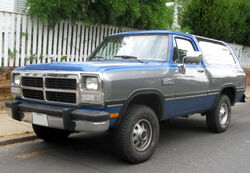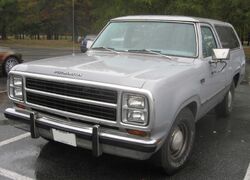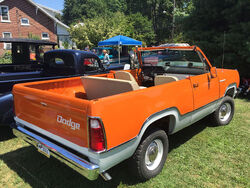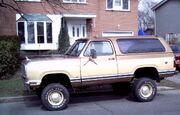 | |
| Manufacturer | Chrysler Corporation |
|---|---|
| Production | 1974–2001 |
| Successor | Dodge Durango (2004) |
| Class | Full-size SUV |
| Body style(s) | 2-door SUV |
| Platform | Front engine, rear-wheel drive / four-wheel drive |
The Dodge Ram Charger is a large sport utility vehicle built by Dodge from 1974 to 1993 (and 1999 to 2001 in Mexico), and based on a shortened-wheelbase version of the Dodge D Series/Ram pickup truck chassis. A Plymouth version, named the Trailduster and offered from 1974 to 1981, was Plymouth's only SUV.
First and second generations[]
 | |
| Also called | Plymouth Trailduster (1974–1981) |
|---|---|
| Production | 1974–1980 |
| Platform | Chrysler AD platform |
| Engine(s) |
225 cu in (3.7 L) I6 318 cu in (5.2 L) V8 360 cu in (5.9 L) V8 440 cu in (7.2 L) V8 |
| Transmission(s) |
4-speed manual 3-speed TorqueFlite automatic |
| Related |
Dodge D Series Dodge Ram |
 | |
| Production | 1981–1993 (1988–1996 In Mexico) |
|---|---|
| Platform | Chrysler AD platform |
| Engine(s) |
318 cu in (5.2 L) V8 360 cu in (5.9 L) V8 |
| Transmission(s) |
3-speed automatic 4-speed manual |
| Wheelbase | 106.0 in (2,692 mm) |
| Length |
1988–1990: 184.6 in (4,689 mm) 1991-93: 188.0 in (4,775 mm) |
| Width | 79.5 in (2,019 mm) |
| Height |
1988–1990 2WD: 69.7 in (1,770 mm) 1988–1990 4WD: 73.1 in (1,857 mm) 1991-93 4WD: 74.1 in (1,882 mm) 1991-93 2WD: 70.6 in (1,793 mm) |
| Related | Dodge Ram |
The Ramcharger was primarily produced as a full-time four wheel drive vehicle, although a two wheel drive version was available starting in 1975. During development, it was known as the "Rhino".[1] 1974 through 1980 models have a removable hard top, although dealer-installed soft tops were available. The first year model differs from the others in that its door pillars are attached to a removable roof.

1974 Ramcharger with optional passenger and rear bench seats
Like many vehicles, the Ramcharger was used in rallying, although its use was very limited. It did have some success, as demonstrated by achieving first place at Sno*Drift in 1975. In 1978 and 1979 the 360 CID's horsepower was bumped up to 195 horsepower (145 kW). 1978 was the last year for the 440 CID, which by then only put out 215 horsepower (160 kW).
Mechanicals[]
The vehicle was usually powered by a Chrysler LA engine, the most common being the 318 cu in (5.2 L) V8. Optional was the 360 cu in (5.9 L) V8 and even big-block B series 400 cu in (6.6 L) V8 and RB 440 cu in (7.2 L) V8 were offered in the early years. Initially a normally aspirated carburetor, in 1988 the 318 gained throttle-body fuel injection with the 360 following in 1989. Power output for the TBI 318 was 230 horsepower (170 kW) and 280 lb (130 kg)-ft of torque. The TBI 360 had 240 hp (180 kW) and 283 to 295 ft·lbf (400 N·m). In 1992 the multiport fuel injected Magnum 318 was the standard engine while the LA 360 with TBI was still offered. In 1993 the Magnum 360 replaced the LA engine version.
Many manual transmissions were offered throughout the years, starting with the A-230 three-speed and ending with the A-535 five-speed in 1992. The NP435 "granny gear" 4 speed was the most common in 4WD models. In 1988 the clutch was converted from a mechanical linkage to a hydraulic system. Automatic transmission models had the Chrysler Loadflite TF-727A or B until, in 1991, it was replaced with the A-500/A-518 four-speed.
A full-time four-wheel drive NP-203 transfer case was standard until 1980, when it was replaced with the part-time NP-208. This was supplanted by the NP-241 in 1988.
Axles were Dana 44 front and 9¼" rear. Full time 4WD models (1974–1979) were equipped with the full time version of the Dana 44 that had no provision for locking hubs and had a front wheel bearing design with a somewhat dubious reputation. In 1980 when the part time 4WD system was introduced, the front Dana 44 was equipped with a more conventional front wheel bearing design and automatic locking hubs. Late in the 1984 model year the Dana 44 was switched to a CAD (Center Axle Disconnect) version. The CAD Dana 44 was vacuum actuated by a switch on the transfer case and powered by engine vacuum. The CAD Dana 44 was carried on until the end of Ramcharger production in 1993. Users often ran into problems with the CAD system. The vacuum switch on the transfer case would occasionally fail and either leave the CAD engaged or not engage the CAD at all. Limited slip differentials were available for the 9¼" rear axle. It should also be noted that the full time 4WD versions used a 5 on 4½" wheel bolt circle and the part time models used a 5 on 5½" bolt circle.

First generation Dodge Ramcharger
Third generation[]
 | |
| Production | 1999–2001 |
|---|---|
| Assembly | Saltillo, Coahuila, Mexico |
| Platform | Chrysler BW Platform |
| Engine(s) |
5.2 L (320 cu in) V8 5.9 L (360 cu in) V8 |
| Transmission(s) |
4-speed automatic 4-speed manual |
| Related | Dodge Ram |
In 1999, a new Ramcharger was produced in Mexico based on the second generation Ram pickup and using parts from the Dodge Ram pickups and other Chrysler vehicles. Sold only in Mexico, where the previous generation Ramcharger had been quite successful, it was not offered in the U.S. Because of this and other issues, this generation never enjoyed the sales of the previous generations of Ramchargers. Powered by the 5.9 and 5.2 Litter (360 CID and 318 CID) Magnum V8 and offered only in 2WD versions, it was discontinued around 2002. One of the most interesting features of this generation was a small folding seat in the cargo area, facing sideways, not a full-sized seat, making it uncomfortable for long trips. The rear hatch door was borrowed from 1996–2000 model Dodge Caravan. The Mexican-market Ramcharger was probably not marketed in the U.S.because the SUV market was favoring 4 or 5-door SUVs as opposed to 2-doors. Also, DaimlerChrysler already had two successful mid-sized SUVs (Jeep Grand Cherokee and Dodge Durango). Two-door SUV sales have been declining, to which GM ended production of its 2-door Tahoe and Yukon, and Ford replaced the long-running 2-door only Ford Bronco around the same time with the 4-door only Ford Expedition
See also[]
References[]
- ↑ Off-Road Adventures, June 2007: page 90
External links[]
Media related to Dodge Ramcharger at Wikimedia Commons
| ||||||||||||||||||||||||||||||
| This page uses some content from Wikipedia. The original article was at Dodge Ramcharger. The list of authors can be seen in the page history. As with Tractor & Construction Plant Wiki, the text of Wikipedia is available under the Creative Commons by Attribution License and/or GNU Free Documentation License. Please check page history for when the original article was copied to Wikia |